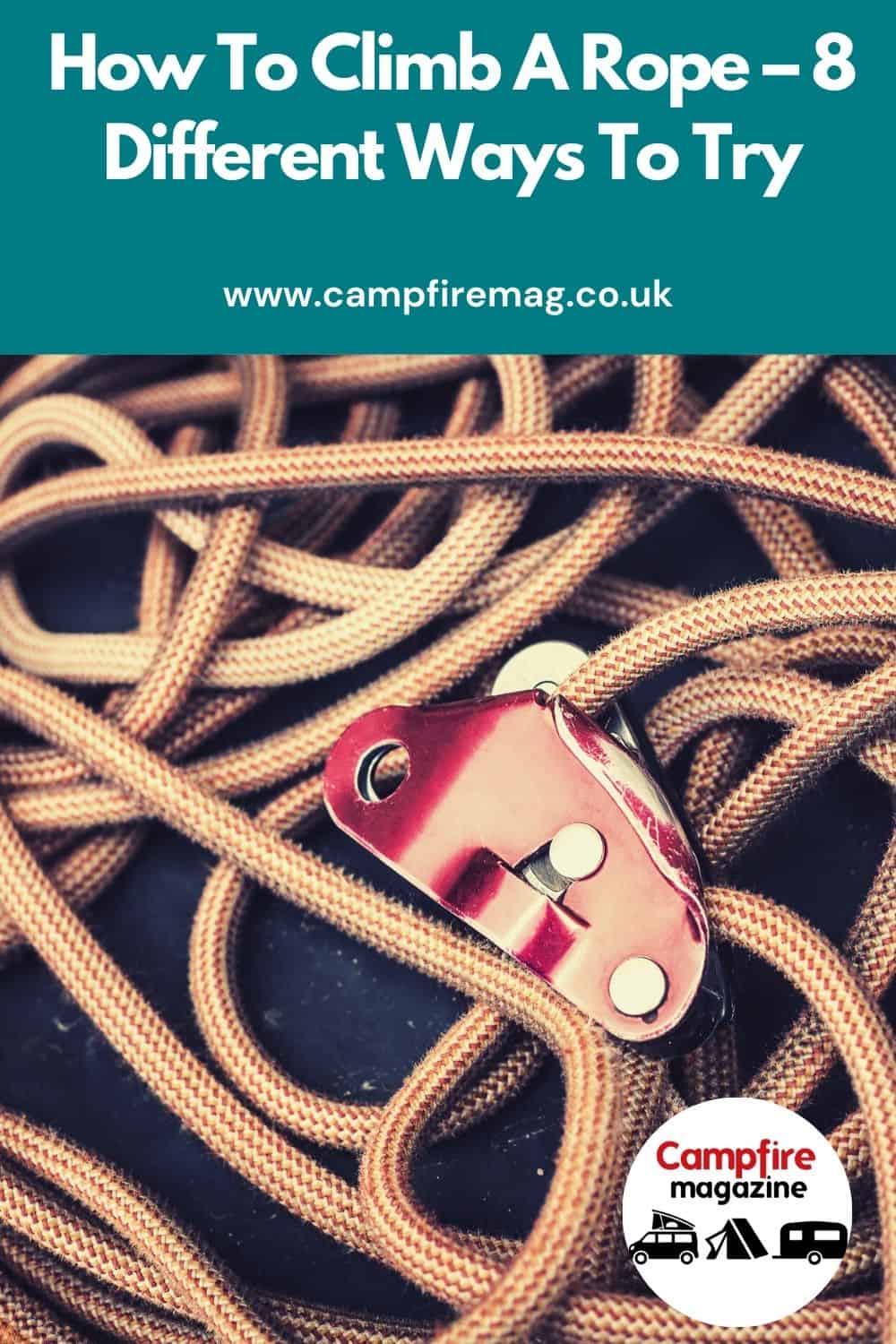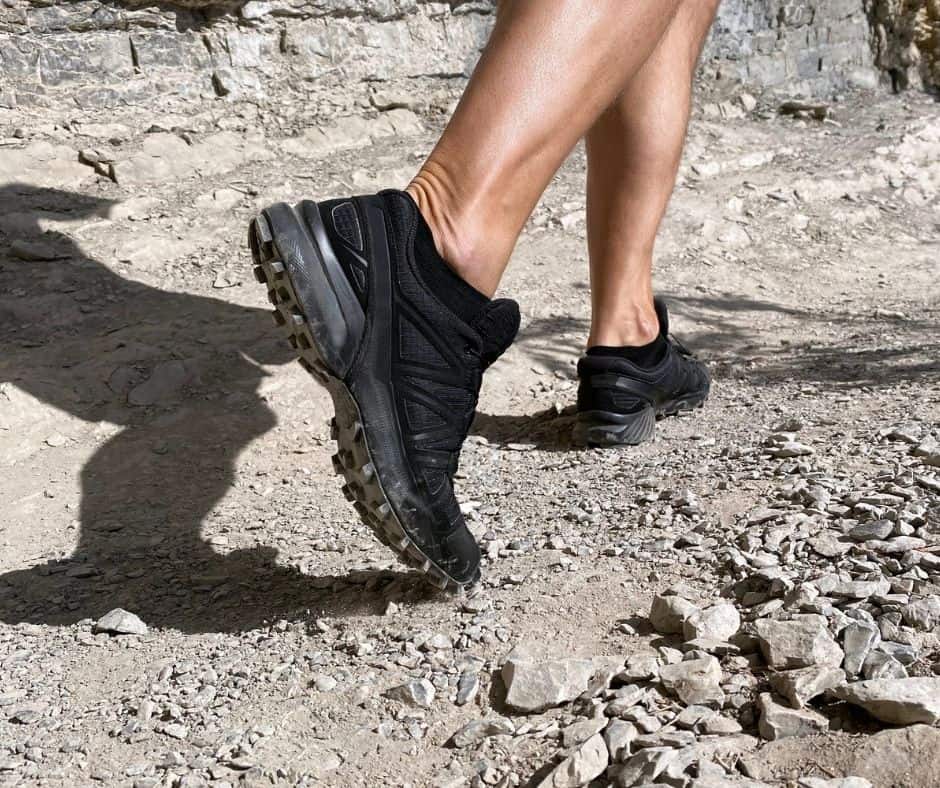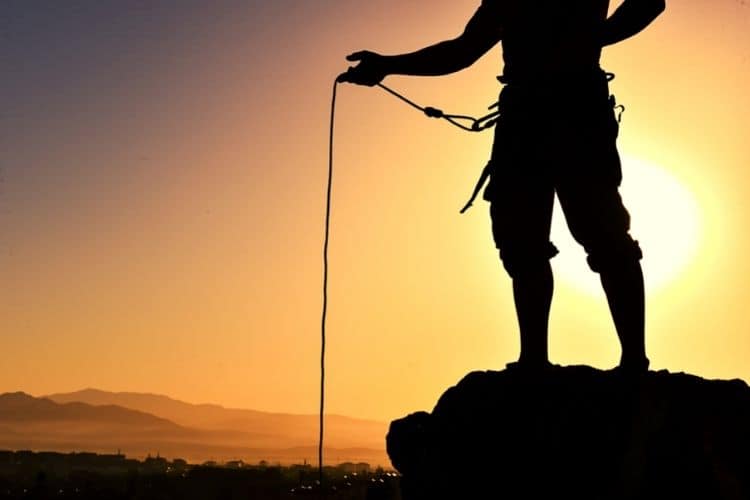Climbing a rope can feel like an incredibly daunting task. But it’s something that’s worth learning how to do because you never know when you might find yourself in a situation where climbing a rope is essential.

Standing at the bottom of a rope and looking up, many of us wonder how on earth we will scale it without sliding straight back down. I thought the same until I discovered some innovative ways to climb a rope and found out how easy it can actually be.
In this guide, I’ll talk you through some of these methods and give you some helpful tips.
Do You Have To Be Strong To Climb A Rope?
I’m not going to sugar coat it; you do need to have a degree of upper body strength in order to climb a rope. That said, there are some techniques that require more upper body strength than others so even beginners will be able to find ways to climb that aren’t quite as challenging.
As well as being strong in the upper body, you must also be able to pull yourself up which a lot of people do find difficult. So, when learning to climb a rope, you not only need to work on your technique but also your physical fitness.
Fortunately, there are lots of ways you can do this. While I will go into detail on various exercises later in this guide, for now, let’s look at the easiest; pull ups. Experts recommend this exercise above all others for rope climbers as it is the closest thing to actual climbing. It will work all of the upper body including the biceps, lats and forearms, all of which you will use when you’re climbing the rope.
What Am I Going To Need To Climb A Rope?
Before you attempt to climb a rope, unless you’re in an emergency or survival situation, it’s worth considering what gear you will wear. This ensures good protection for your body as well as making tackling the rope climb much easier.
Gloves
Perhaps one of the most important things for a lot of rope climbing activities is a pair of gloves. It is very common to get rope burn when climbing but a tough, protective pair of gloves with help to prevent this. The gloves you choose will depend on several factors including the weather and the type of rope you are using.
Shoes
When it comes to choosing shoes for rope climbing, you might be surprised to learn that there is actually footwear designed just for this purpose. Take the Invo Rope Tech F Lite shoes for example which are kitted out with features designed to help you tackle rope climbing more easily.
The shoes you select for rope climbing should have excellent grip as this will go a long way in preventing you from slipping. The shoes will also have rope technology on the sides which helps to avoid abrasion. It’s worth shopping around for a pair that suits exactly what you’ll be doing.

Types Of Rope
As well as choosing gear that is going to make rope climbing much simpler, you have to think about the type of rope you’re going to climb. Many newbies are under the impression that a rope is a rope but this is far from the truth. Let’s take a look at some of the most common climbing ropes and what they’re good for.

The Manila Rope
These ropes are made using fibres from the abaca plant and are one of the most common types of climbing rope. In fact, they are commonly used in gyms, the military and in schools so you more than likely experienced one back in your PE days at school.
The Manila rope is incredibly durable and while it is prone to fraying, it won’t falter and will last for many years. What’s more, these ropes tend to be much wider so are more reliable when it comes to holding your weight.
It’s a good starter rope and they’re very easy to source as well as being relatively affordable.
The Double Braided Nylon Rope
As the name suggests, this type of rope features double braiding. The first is that of the inner core which is then covered with a second braid. The benefit of this is that the rope is much more easily able to retain its shape so is less likely to fray. The result of this is that your hands won’t suffer as much if the surface is not as abrasive.
The ropes are very strong and much more comfortable to climb than other types. Therefore, if you have sensitive hands, this might be a good option.
The Polyester Rope
If you find that Manila ropes are a little too abrasive on your hands then you might prefer a polyester rope as these are generally much gentler on the hands. However, the polyester rope is still a very thick and durable rope so you won’t have any concerns about its strength.
What’s more, these ropes are much more lightweight making them ideal for adventures and outings where you already have a lot to carry. It will last for many years so it could become your go-to rope!
The Single Rope
Single ropes are excellent for using when you are trying to scale something like a wall or rocky cliff, for example. However, you must be very careful about the type of rope you buy as it has to be suitable for you.
You will need to consider how heavy the rope is as well as how much weight it is designed to carry. Of course, choosing something more lightweight is ideal for climbing adventures as long as it will hold you safely.
Why Would I Climb A Rope Anyway?
All this talk of climbing ropes can make you feel a little eager to get started. But when you stop and think about it, you might wonder why you’d even want to bother learning how to climb a rope. Well, let me be the first to tell you that there are several reasons this is a skill worth having.
Above all else, climbing a rope is a great way to stay in shape. Once you have developed the right level of upper body strength, it’s the perfect way to maintain this as well as giving yourself a full body workout. Additionally, rope climbing will improve your grip and endurance so it’s a great all-rounder. Plus, you can tailor the workout to your abilities so nobody has to miss out.
Learning to climb a rope is an essential life skill when you consider that you may find yourself in a survival situation some day. While this isn’t highly likely for most people, there is always a chance and being able to lift your own body weight and climb a rope could save your life one day!
But of course, it isn’t all so serious; rope climbing is a great way to have fun! There are tons of rope obstacle courses dotted around the country so it’s a fun weekend activity that all members of the family can get involved with. If you’ve been struggling to think of what to do on the weekends, this could be a new family favourite!

8 Ways To Try For Climbing A Rope
There’s no one way to skin a cat, as the saying goes, and the same is true for climbing a rope. Whether you’re just starting out or have a lot more experience, I’ve put together a list of rope climbing methods with something to suit everyone.
The Wrap And Lock Method
If you are just beginning with rope climbing and are still working on your upper body strength then the wrap and lock method is going to be the best place to start. This is because you won’t need as much upper body strength although it is worth noting that it is a slower technique.
Start by getting onto the rope and allowing it to sit between your thighs. Keep the arms extended.
Next, bring your knees up and use one foot to steep down onto the rope while the other foot is pressed onto the loose end.
Using the foot that is unwrapped, you can trap the rope between your two feet. Ensure you squeeze as tight as possible to keep everything secure.
Using your leg strength, push up so that the legs become straight, this will allow you to reach up with your hands and move up the rope.
The Stomp And Stand Method
This method is a variation of the wrap and lock method but it requires the use of even less upper body strength. However, you will be more susceptible to rope burn on the legs so it’s worth wearing a longer, thicker pair of trousers if you can.
Start by wrapping one leg around the back of the rope and one around the front. The result should be that the rope sits nicely along your thigh before curving to the back of your leg.
Take your hands and reach up to grab the rope at the same time and bring your knees up with the rope remaining wrapped around the leg.
Using your free foot, stomp down onto the rope so that it is pushed down into the bottom foot.
You can now straighten the legs, allowing you to take hold of the rope further up.
To move on again, you will need to ensure that the rope stays wrapped around the leg before releasing the upper foot and bringing the knees back up. Then repeat the whole sequence.
The Spanish Method
This is yet another take on the wrap and lock method but is ideal for people whose leg strength isn’t quite as good as it is the hips that will do most of the work.
Begin this technique in the same way as the last by wrapping the rope around your leg in the front and back.
Again, you will need to reach up and take hold of the rope with the hands. While doing this, you should tuck the knee of the wrapped leg as the rope slides down, then straighten your leg.
At this stage, your legs should be directly in front of you, almost like a sitting position. Use your free foot to press onto the top of the rope near your ankle. Once you are happy that you have secured the rope, you can straighten the legs so that you are in a standing position.
Repeat these steps as many times as you need to get to the top of the rope.
The Gym Class Method
You may hear this technique being referred to as the grip and lock method but they’re the same thing. Most children would have been taught this method in school so it may seem familiar to you. It’s excellent for beginners but due to how inefficient it is, is probably not something you’ll use once you become more experienced. Also keep in mind that, for this method, you will need a lot of upper body strength.
Stand on the ground, raise your arms and grab hold of the rope.
Now jump onto the rope and secure it between the feet.
You will use your feet to push yourself up the rope, allowing you to reach higher with the hands. It’s important to keep the rope tight in your hands and ensure your knees are tucked in.
Repeat these steps until you reach your desired height.
It is possible to put knots into the rope to make climbing easier since these act as a support for the feet. You’ll use the technique in exactly the same way but just place your feet on either side of the knots.
The L Sit Method
As you may guess from the name, the L sit method involves having your legs out in front of you so that your body is in an L shape.
Standing on the ground, take the rope and grip it in your hands with the legs directly out in front.
Use the hands to help you climb up the rope by moving the lower one above the upper hand and so on until you reach the top.
The Walk Method
If you are climbing a vertical surface like a wall, this is a great method. However, it does require a good amount of upper body strength so make sure you have worked on this before you attempt anything. Since you will be at an acute angle to the wall, it’s important to take it slowly and maintain good control.
With the rope in front of you, take hold of it securely with both hands.
Now put the feet onto the vertical surface in front of you and start walking up it.
You will come to a point where you cannot move your feet and higher so you will need to pull yourself up with your arms.
Now you can move the feet again and simply keep repeating this until you get to the top.
When you want to come back down, simply do it all in reverse.
The Upper Body Climb Method
It doesn’t take me to tell you that this method requires excellent upper body strength so should be reserved for more advanced or stronger climbers. You won’t be able to rely on your legs at all for this technique. It’s a simple method in theory but much more difficult than it looks.
Take hold of the rope as high as possible from your starting point on the ground.
Use your hands to climb up, moving the lower hand above the upper hand and repeating to the top of the rope.
The Two Rope Method
This final technique also requires a good amount of upper body strength so again, shouldn’t be attempted by beginners. As you’ll probably guess from the name, it also involves using a pair of ropes as opposed to just the one. Moreover, your feet aren’t involved at all.
Set your ropes up so that they are about shoulder width apart.
Hold one rope in one hand and the other rope in the other hand so that you are standing in between the two ropes.
Using your upper body strength, pull yourself up each rope using one hand at a time. The feet should dangle between them
Hold tightly to the rope on the right side while you slide your left hand up the rope, securing your grip once you are fully extended.
Repeat this on the other side and continue switching until you reach the top.
Developing Physical Strength For Rope Climbing
As I mentioned earlier in this guide, not everyone has the right amount of physical strength to just jump on a rope and start climbing. But that’s OK; everyone has to start somewhere and just because you may currently have problems, that doesn’t mean that you can’t go on to become the best rope climber you can be.
There are several exercises you can do to build your strength and prepare yourself for climbing ropes. It’s essential to take things slowly and not push yourself. If you do, you’ll likely end up injuring yourself and then you won’t be climbing anything.
Farmer Carry
The farmer's carry is excellent if you need to improve your grip; which you will when learning to climb a rope! You will need two items of an equal weight such as dumbbells. If you don’t have these, you can get creative and use something like a bucket filled with sand or water.
Keep the arms straight and pick up the items, holding them at your sides. Now simply walk up and down the room, your garden or anywhere else you wish to do the workout.
Leg Raises
You’re going to need to work on your leg strength for some of the techniques we have looked at so leg raises are an ideal exercise for this.
You will need a bar to hang from and as you are doing this, it’s simply a matter of lifting the legs up. This is also a great core workout which will also come in handy when you’re climbing a rope.
Towel Pulls
For this exercise, you will need to chuck a towel over a bar and take hold of either end. You can then use the towel to lift yourself off the ground, pulling one side of the towel and then the other which will lift and lower you.
Rope Pull Ups
If you have been out and purchased a rope then you might as well put it to good use, even if you’re not ready to climb it just yet.
Reach up with the hands and grab onto the rope. Allow yourself to hang here with the knees bent for as long as you can. Then lower yourself back down and do it all again.
Close Grip Chins
Again you will need a bar for this exercise. Place the hands onto the bar close together with the palms pointing away from you.
Now extend the arms completely before bending the elbows which will lift you off the ground so that you are in line with the hands.
Squats
Since you are going to need to be able to pull your body weight up the length of the rope, squats will help you with this. Once you become adept at regular squats, you might try doing the one legged version which is much tougher but will certainly build strength.
Jumping Pull Ups
If you find regular pull ups a little difficult then you could try jumping pull ups. These require a rope which you will take hold of in line with your head. You will then bend your knees and hang from the rope using the legs to help you jump down and pull yourself up.
There’s no need to try to jump excessively high. The aim here is just to pull yourself up so that your chin comes over your hands. This is also a good core workout that requires excellent control.
Row And Switch
For this exercise, you will again be making use of your rope. Take it with both hands and move your feet back so that you are standing at an angle. You will use your arms to anchor yourself and you’ll also need to use your core to keep the body straight.
When you are in the correct stance, push the chest forward and swap your hands moving the lower one above the upper one. Now lean backwards and move the hands again.
Bent Knee Horizontal Climb
If you are looking to work on your grip strength or to strengthen your biceps and back then this is an excellent workout. You will begin by standing on the ground and taking hold of the rope in line with your head. Make sure that your core is engaged and then lean back and lower down moving one hand over the other.
As you lower down, make sure to bend your needs and get as close to the ground as you can before moving up again.
Straight Leg Horizontal Climb
This is a very similar workout to the previous one only this time, your legs will be kept straight. There is also the option to adjust this one by changing how high or low you hold the rope.
Start by standing with the feet shoulder width apart and putting the rope between them. Now take hold of the rope with one hand over the other and walk back so that you are more horizontal.
Keep the core engaged and make sure that your body remains in a straight line. Allow yourself to go as close to the floor as possible before pulling yourself back up the rope. Repeat this as many times as you wish.
Conclusion
Climbing a rope seems like an impossible task for some people but it doesn’t have to be. Yes, you will need to work on your upper body, core strength and grip but there are different rope climbing techniques that you can use according to your level of experience.
It’s also important to make sure you choose the right type of rope and wear suitable gear such as gloves and appropriate shoes. Then it’s just a case of practice makes perfect and you’ll have some great fun along the way.
